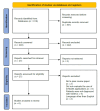The Impact of Mobile Health (mHealth) Apps on Gestational Diabetes: A Systematic Review
- PMID: 39980710
- PMCID: PMC11841959
- DOI: 10.7759/cureus.79375
The Impact of Mobile Health (mHealth) Apps on Gestational Diabetes: A Systematic Review
Abstract
Gestational diabetes mellitus (GDM) poses a significant health risk for pregnant women, as it is associated with an increased likelihood of developing type II diabetes and cardiovascular complications. In addition, there is a high risk for pregnancy-related complications, emphasizing the need for effective management of GDM. This study aimed to investigate the potential impact of mHealth applications on gestational diabetes-related outcomes. A systematic review was conducted, following the Preferred Reporting Items for Systematic Reviews and Meta-Analyses (PRISMA) guidelines. The search was conducted in Pubmed, Scopus, and Web of Science, using the following search terms: (smartphone* OR mobile OR mHealth OR "mobile health") AND ("gestational diabetes" OR "maternal diabetes" OR "pregnancy diabetes" OR "pregnancy-induced diabetes" OR "perinatal diabetes"). In order to be included in the systematic review, the studies had to be papers published in peer-reviewed journals, published from February 2, 2020 to February 2, 2025, in the English language, being randomized trials, evaluating the impact of mHealth apps on women with GDM, excluding studies that incorporated additional technological interventions (e.g., WeChat supportive groups). The extracted data were the following: authors, country, total and per group number of participants, participants' characteristics, interventional content, assessments, time of the assessments, results, and potential information about participant adherence. The Jadad Scale was used for quality evaluation. Six studies met the predefined criteria and were included in the systematic review. Three studies found no or minimal benefits from the use of such applications. One study demonstrated highly significant benefits, not only in the management of GDM but also in reducing pregnancy-related complications. Another study indicated greater adherence to treatment and fewer admissions to neonatal intensive care units, while a third study reported a shift toward better postpartum health behaviors, which was closely associated with the use of mHealth applications, suggesting that those apps could support women in adopting healthier habits after childbirth. All studies reporting positive outcomes were carried out in Eastern Asian Countries (Singapore and China), whereas studies conducted in Europe found minimal or no benefits. The score on the Jadad Scale ranged from 2 to 3, indicating moderate to low quality. Οverall, while some promising findings were observed, further research is essential to evaluate these apps more thoroughly and enhance their effectiveness. Greater culturally influenced adherence to healthcare instructions leads to more significant benefits for Asian women with GDM. Cultural factors should be carefully considered when designing and implementing mHealth applications for women with GDM.
Keywords: diabetes gestational; intelligent systems; mobile apps (mhealth); pregnancy; women.
Copyright © 2025, Giaxi et al.
Conflict of interest statement
Conflicts of interest: In compliance with the ICMJE uniform disclosure form, all authors declare the following: Payment/services info: All authors have declared that no financial support was received from any organization for the submitted work. Financial relationships: All authors have declared that they have no financial relationships at present or within the previous three years with any organizations that might have an interest in the submitted work. Other relationships: All authors have declared that there are no other relationships or activities that could appear to have influenced the submitted work.
Figures
Similar articles
-
Cultural and Digital Health Literacy Appropriateness of App- and Web-Based Systems Designed for Pregnant Women With Gestational Diabetes Mellitus: Scoping Review.J Med Internet Res. 2022 Oct 14;24(10):e37844. doi: 10.2196/37844. J Med Internet Res. 2022. PMID: 36240008 Free PMC article.
-
Effects of mHealth-Based Lifestyle Interventions on Gestational Diabetes Mellitus in Pregnant Women With Overweight and Obesity: Systematic Review and Meta-Analysis.JMIR Mhealth Uhealth. 2024 Jan 17;12:e49373. doi: 10.2196/49373. JMIR Mhealth Uhealth. 2024. PMID: 38231555 Free PMC article.
-
Personalized and Culturally Tailored Features of Mobile Apps for Gestational Diabetes Mellitus and Their Impact on Patient Self-Management: Scoping Review.JMIR Diabetes. 2024 Dec 12;9:e58327. doi: 10.2196/58327. JMIR Diabetes. 2024. PMID: 39665748 Free PMC article.
-
Effectivness of specific mobile health applications (mHealth-apps) in gestational diabtetes mellitus: a systematic review.BMC Pregnancy Childbirth. 2021 Dec 5;21(1):808. doi: 10.1186/s12884-021-04274-7. BMC Pregnancy Childbirth. 2021. PMID: 34865645 Free PMC article.
-
Assessing the Views and Needs of People at High Risk of Gestational Diabetes Mellitus for the Development of Mobile Health Apps: Descriptive Qualitative Study.JMIR Form Res. 2022 Jul 8;6(7):e36392. doi: 10.2196/36392. JMIR Form Res. 2022. PMID: 35802414 Free PMC article.
References
-
- Increased risk of type II diabetes mellitus and cardiovascular disease after gestational diabetes mellitus: a systematic review. Hopmans TE, Van Houten C, Kasius A, et al. Ned Tijdschr Geneeskd. 2015;159:8043. - PubMed
-
- Gestational diabetes and the risk of cardiovascular disease in women: a systematic review and meta-analysis. Kramer CK, Campbell S, Retnakaran R. Diabetologia. 2019;62:905–914. - PubMed
-
- The association between gestational diabetes mellitus and cancer in women: a systematic review and meta-analysis of observational studies. Wang Y, Yan P, Fu T, Yuan J, Yang G, Liu Y, Zhang ZJ. Diabetes Metab. 2020;46:461–471. - PubMed
Publication types
LinkOut - more resources
Full Text Sources
Miscellaneous

